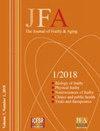2019冠状病毒病大流行期间,日本社区老年妇女的社会疏离影响了肌肉质量和力量
IF 3.3
Q2 GERIATRICS & GERONTOLOGY
引用次数: 11
摘要
冠状病毒病(COVID-19)导致的社会疏远导致身体活动减少,导致老年人肌肉减少和身体虚弱。本研究旨在比较第一波COVID-19大流行(2020年4月至5月)前后老年妇女的肌肉质量、力量和功能值。此外,研究人员还研究了因COVID-19大流行而对社会参与受到不同程度影响的女性肌肉测量的变化。对46名居住在日本社区的老年妇女(平均77.5岁;范围66-93),在第一波COVID-19大流行之前和之后。在第一波大流行之后,躯干肌肉质量显著下降。当比较大流行期间增强/维持组和降低组之间的变化值时,观察到躯干肌肉质量、握力和口腔运动技能的显著组差异。有趣的是,那些加强社会参与的人握力值发生了积极变化,这表明社会参与可能会影响COVID-19大流行期间的肌肉功能。本文章由计算机程序翻译,如有差异,请以英文原文为准。
Social Detachment Influenced Muscle Mass and Strength during the COVID-19 Pandemic in Japanese Community-Dwelling Older Women
Social detachment due to Coronavirus disease (COVID-19) has caused a decline in physical activity, leading to sarcopenia and frailty in older adults. This study aimed to compare muscle mass, strength, and function values in older women before and after the first wave of the COVID-19 pandemic (April–May 2020). Furthermore, changes in muscle measures across women who experienced different levels of impact on their social participation due to the COVID-19 pandemic were examined. Muscle mass (total, trunk, and appendicular muscle), grip strength, oral motor skills, social interactions (social network and participation), and social support were assessed in 46 Japanese community-dwelling older women (mean, 77.5 y; range 66–93 y) before and after the first wave of the COVID-19 pandemic. Trunk muscle mass significantly decreased after the first wave of the pandemic. When comparing changed values between the enhanced/maintained and reduced group during the pandemic, significant group difference was observed in trunk muscular mass, grip strength, and oral motor skills. Intriguingly, those who enhanced social participation had a positive change of grip strength values, showing that social participation might influence muscle function during the COVID-19 pandemic.
求助全文
通过发布文献求助,成功后即可免费获取论文全文。
去求助
来源期刊

Journal of Frailty & Aging
GERIATRICS & GERONTOLOGY-
CiteScore
5.90
自引率
7.70%
发文量
54
期刊介绍:
The Journal of Frailty & Aging is a peer-reviewed international journal aimed at presenting articles that are related to research in the area of aging and age-related (sub)clinical conditions. In particular, the journal publishes high-quality papers describing and discussing social, biological, and clinical features underlying the onset and development of frailty in older persons. The Journal of Frailty & Aging is composed by five different sections: - Biology of frailty and aging In this section, the journal presents reports from preclinical studies and experiences focused at identifying, describing, and understanding the subclinical pathophysiological mechanisms at the basis of frailty and aging. - Physical frailty and age-related body composition modifications Studies exploring the physical and functional components of frailty are contained in this section. Moreover, since body composition plays a major role in determining physical frailty and, at the same time, represents the most evident feature of the aging process, special attention is given to studies focused on sarcopenia and obesity at older age. - Neurosciences of frailty and aging The section presents results from studies exploring the cognitive and neurological aspects of frailty and age-related conditions. In particular, papers on neurodegenerative conditions of advanced age are welcomed. - Frailty and aging in clinical practice and public health This journal’s section is devoted at presenting studies on clinical issues of frailty and age-related conditions. This multidisciplinary section particularly welcomes reports from clinicians coming from different backgrounds and specialties dealing with the heterogeneous clinical manifestations of advanced age. Moreover, this part of the journal also contains reports on frailty- and age-related social and public health issues. - Clinical trials and therapeutics This final section contains all the manuscripts presenting data on (pharmacological and non-pharmacological) interventions aimed at preventing, delaying, or treating frailty and age-related conditions.The Journal of Frailty & Aging is a quarterly publication of original papers, review articles, case reports, controversies, letters to the Editor, and book reviews. Manuscripts will be evaluated by the editorial staff and, if suitable, by expert reviewers assigned by the editors. The journal particularly welcomes papers by researchers from different backgrounds and specialities who may want to share their views and experiences on the common themes of frailty and aging.The abstracting and indexing of the Journal of Frailty & Aging is covered by MEDLINE (approval by the National Library of Medicine in February 2016).
 求助内容:
求助内容: 应助结果提醒方式:
应助结果提醒方式:


